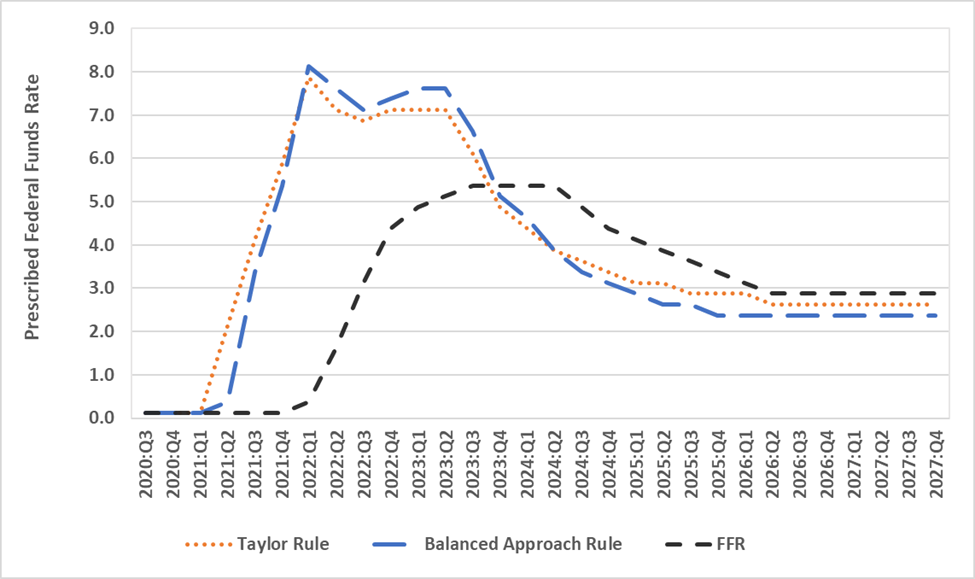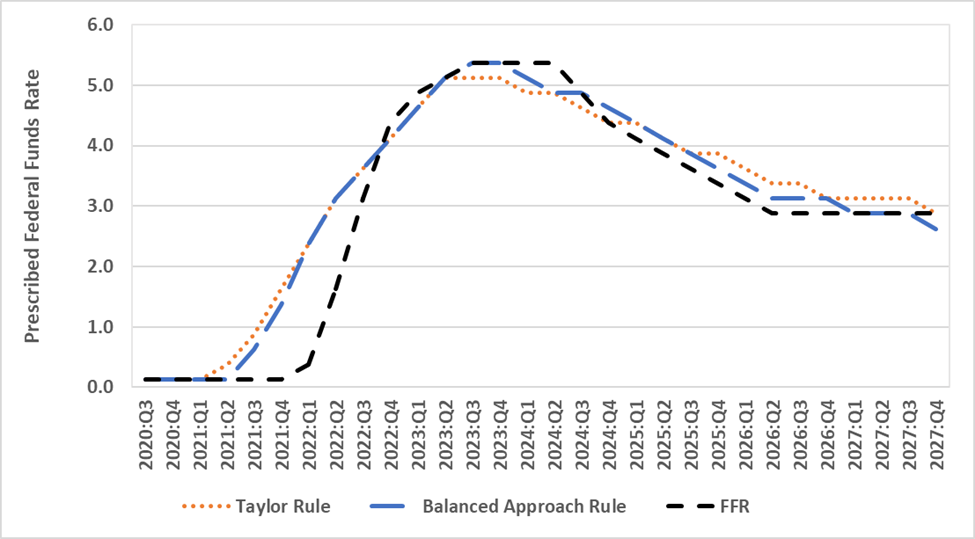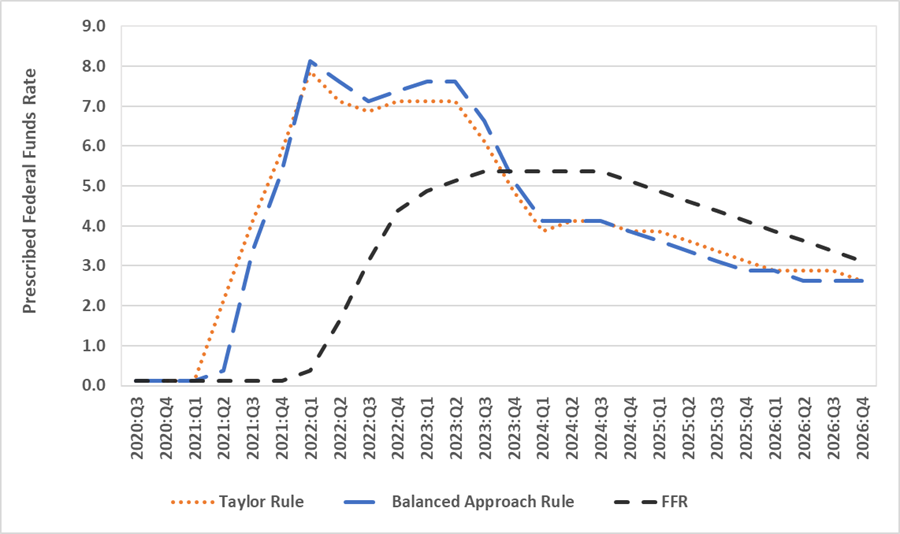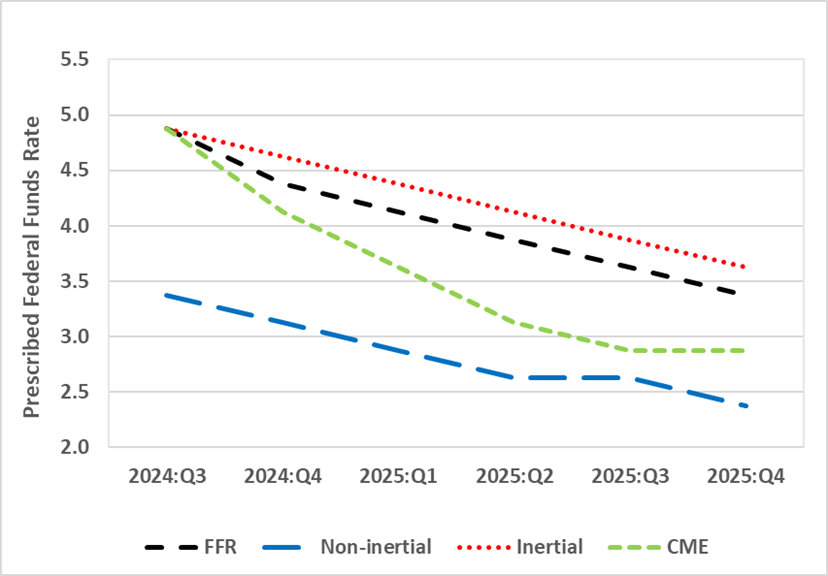Today, we present a guest post written by David Papell and Ruxandra Prodan-Boul, Professor of Economics at the University of Houston and Economics Lecturer at Stanford University.
The Federal Open Market Committee (FOMC) lowered the target range for the federal funds rate (FFR) by ½ percentage point from 5.25 – 5.5 percent to 4.75 – 5.0 percent at its September 2024 meeting and, in the Summary of Economic Projections (SEP), projected further decreases with a range for the FFR between 4.25 and 4.5 percent by the end of 2024 and between 3.25 and 3.5 percent by the end of 2025. Futures markets summarized by the CME FedWatch Tool after the meeting predicted a faster path of rate cuts with a range for the FFR between 4.00 – 4.25 percent by the end of 2024 and between 2.75 – 3.00 percent by the end of 2025.
We compare the FOMC projections and CME predictions to prescriptions of non-inertial policy rules where the FOMC achieves the desired rate immediately and inertial policy rules where the FOMC smooths rate changes. The post is based on two of our papers. “Policy Rules and Forward Guidance Following the Covid-19 Recession,” published online in the Journal of Financial Stability, and “Alternative Policy Rules and Fed Policies,” which use data from the SEP’s for September 2020 to June 2024 to compare a wide variety of policy rule prescriptions with actual and FOMC projections of the FFR. In this post, we analyze four policy rules that are relevant for the future path of the FFR, update the policy rule prescriptions through December 2027 from the September 2024 SEP, and include futures market predictions.
The Taylor (1993) rule with an unemployment gap is as follows,

where is the level of the short-term federal funds interest rate prescribed by the rule, is the inflation rate, is the 2 percent target level of inflation, is the 4 percent rate of unemployment in the longer run, and is the current unemployment rate. is the neutral real interest rate from the SEP which equals 0.5 percent between September 2020 and December 2023, 0.6 percent in March 2024, 0.8 percent in June 2024, and 0.9 percent in September 2024.
Yellen (2012) analyzed the balanced approach rule where the coefficient on the inflation gap is 0.5 but the coefficient on the unemployment gap is raised to 2.0.

The balanced approach rule received considerable attention following the Great Recession and became the standard policy rule used by the Fed.
These rules are non-inertial because the FFR fully adjusts whenever the target FFR changes. This is not in accord with FOMC practice to smooth rate increases when inflation rises. We specify inertial versions of the rules based on Clarida, Gali, and Gertler (1999),

where is the degree of inertia and is the target level of the federal funds rate prescribed by Equations (1) and (2). We set as in Bernanke, Kiley, and Roberts (2019). equals the rate prescribed by the rule if it is positive and zero if the prescribed rate is negative.
Figure 1 depicts the midpoint for the target range of the FFR for September 2020 to September 2024 and the projected FFR for December 2024 to December 2027 from the September 2024 SEP. Figure 1 also depicts policy rule prescriptions. Between September 2020 and September 2024, we use real-time inflation and unemployment data that was available at the time of the FOMC meetings. Between December 2024 and December 2027, we use inflation and unemployment projections from the September 2024 SEP. The differences in the prescribed FFR’s between the inertial and non-inertial rules are much larger than those between the Taylor and balanced approach rules.
Policy rule prescriptions are reported in Panel A for the non-inertial Taylor and balanced approach rules. They are much higher than the FFR in 2022 and 2023 and are not in accord with the FOMC’s practice of smoothing rate increases when inflation rises. In contrast, while the policy rule prescriptions for 2024 through 2027 from the September 2024 SEP are consistently lower than the FFR projections, the gap narrows considerably in 2026 and 2027. The inertial rules in Panel B prescribe a much smoother path of rate increases in 2021 and 2022 than that adopted by the FOMC. Between December 2022 and September 2024, the policy rule prescriptions are close to the FOMC projections and, looking forward, the prescriptions continue to be close to the projections.
Figure 1. The Federal Funds Rate and Policy Rule Prescriptions for September 2024
Panel A. Non-Inertial Rules
Panel B. Inertial Rules
Figure 2 illustrates the federal funds rate projections and policy rule prescriptions from the June 2024 SEP to see how much has changed in the past three months. Panel A depicts prescriptions from the non-inertial rules. For the Taylor rule, the gap between the projections and the predictions is about the same in 2024 and 2025 with the June and September SEP’s because the rate decreases are approximately equal. For the balanced approach rule, the gap is smaller because forecasted unemployment increased between the June and September SEP’s and the FFR responds more to increases in the unemployment gap with the balance approach rule than with the Taylor rule. The gap between the projections and the predictions narrows in 2026 for both rules. Panel B depicts prescriptions from the inertial rules. While the size of the gaps is narrow and similar between the June and September SEP’s, the FFR projections are generally above both policy rule prescriptions in June and below both prescriptions in September.
Figure 2. The Federal Funds Rate and Policy Rule Prescriptions for June 2024
Panel A. Non-Inertial Rules
Panel B. Inertial Rules
Figure 3 shows the median predictions from futures markets in the CME FedWatch Tool the day following the September 2024 FOMC meeting through the end of the CME prediction horizon in September 2025. The futures markets predict sharper decreases in the FFR than the FOMC projections. We add to this discussion by including prescriptions from policy rules. Figure 3 shows that, for both Taylor and balanced approach rules, the prescriptions from the inertial policy rules for December 2024 through December 2025 are above the futures market forecasts. For the non-inertial Taylor rule, the prescriptions are below the futures market predictions through June 2025 and equal thereafter. For the non-inertial balanced approach rule, the prescriptions are always below the futures market predictions. Comparison between futures market predictions and policy rule prescriptions depends more on the choice between inertial and non-inertial rules than on the choice between Taylor and balanced approach rules.
Figure 3: The Federal Funds Rate, CME FedWatch Tool and Policy Rule Prescriptions
Panel A. Taylor Rules
Panel B. Balanced Approach Rules
This post written by David Papell and Ruxandra Prodan-Boul.










